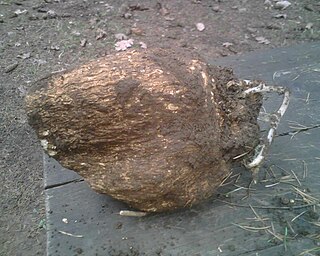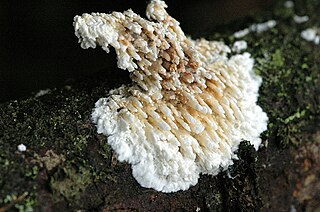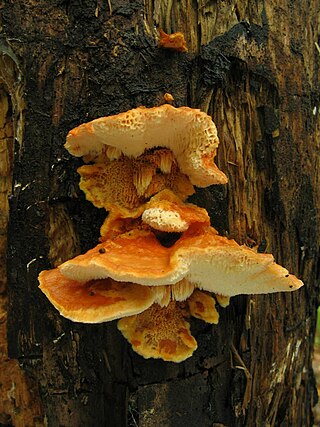
The Hymenochaetales are an order of fungi in the class Agaricomycetes. The order in its current sense is based on molecular research and not on any unifying morphological characteristics. According to one 2008 estimate, the Hymenochaetales contain around 600 species worldwide, mostly corticioid fungi and poroid fungi, but also including several clavarioid fungi and agarics. Species of economic importance include wood decay fungi in the genera Phellinus and Inonotus sensu lato, some of which may cause losses in forestry. Therapeutic properties are claimed for Inonotus obliquus ("chaga") and Phellinus linteus, both of which are now commercially marketed.
Scutula is a genus of lichenicolous fungi in the family Ramalinaceae.
Hyphodontia aspera is a species of fungus in the family Schizoporaceae.

Hyphodontia sambuci, the elder whitewash, is a basidiomycete fungal pathogen on deadwood, especially elder.
Resupination is derived from the Latin word resupinus, meaning "bent back with the face upward" or "on the back". "Resupination" is the noun form of the adjective "resupine" which means "being upside-down, supine or facing upward".

Wolfiporia is a genus of fungi in the family Polyporaceae. The genus was circumscribed by Leif Ryvarden and Robert Lee Gilbertson in 1984 to contain the type species Wolfiporia cocos and W. dilatohypha. The genus is named in honor of mycologist Frederick Adolph Wolf, who was the first to officially describe the type species.
Clohiesia is a genus of fungi in the family Annulatascaceae of the Ascomycota. They inhabit fresh water.

Apiospora is a genus of fungi which cause plant diseases. It gives its name to the family Apiosporaceae, which contains a number of other genera. This is historically a name for the teleomorph (sexual) life-cycle stage of the fungus; for some species the corresponding anamorph name is Arthrinium.
Chaetosphaeria is a genus of fungi in the family Chaetosphaeriaceae.

The hydnoid fungi are a group of fungi in the Basidiomycota with basidiocarps producing spores on pendant, tooth-like or spine-like projections. They are colloquially called tooth fungi. Originally such fungi were referred to the genus Hydnum, but it is now known that not all hydnoid species are closely related.

Fibrodontia is a genus of fungi in the Hydnodontaceae family. The widely distributed genus was circumscribed by Erast Parmasto in 1968. According to Index Fungorum, the type species Fibrodontia gossypina is currently known as Hyphodontia gossypina (Parmasto) Hjortstam.

Hyphodontia is a genus of fungi in the family Hymenochaetaceae. The genus was circumscribed by Swedish mycologist John Eriksson in 1958.

Wolfiporia curvispora is a species of fungus in the order Polyporales. It is found in Jilin, China, where it grows on the rotting wood of Pinus koraiensis. The fungus was described as new to science in 1998 by mycologist Yu-Cheng Dai. The fruitbodies of the fungus are resupinate, meaning they lie flat on the substrate, and have dimensions of up to 3 metres (10 ft) long by 70 cm (28 in) wide by 1 centimetre (0.4 in) thick. They are creamy white, soft, and light. The hyphal system is dimitic, comprising generative and skeletal hyphae. The specific epithet curvispora refers to the curved spores.

In Finland, Kotiranta and Niemelä introduced a widely used method for comparing the conservation values of different forest areas, based on the observation that certain wood-rotting fungi are very sensitive to the impact of human activities on forest ecosystems. Such species are slow to return to areas from where they have disappeared, so their presence is evidence of a long continuity in forest ecosystems.
Libertella is a genus of fungi belonging to the family Diatrypaceae.
Ramboldia curvispora is a species of crustose lichen in the family Ramboldiaceae. Found in Australia, it was described as a new species in 2017 by lichenologists John Elix and Patrick McCarthy. The type specimen was collected from Callala Bay, where it was found on a vertical shale cliff subject to sea spray and surface runoff from the top of the cliff. The specific epithet refers to its characteristic curved ascospores. The lichen is only known to occur on the South Coast of New South Wales, where it grows on both hard and soft siliceous rocks.
Kurt Egon Hjortstam (1933–2009) was a Swedish mycologist, specialising in the taxonomy of corticioid fungi.
Occultifur is a genus of fungi in the family Cystobasidiaceae. Species are parasites of other fungi and, microscopically, have auricularioid basidia and basidiospores that germinate by yeast cells. Several species are currently only known from their yeast states. The genus is distributed worldwide.
Parauncinula is a genus of fungi in the family Erysiphaceae. It is the earliest-diverging genus of powdery mildews and contains only two species, which were formerly classified in Uncinula. Both of these species are endemic to East Asia and infect trees of the Fagaceae.








